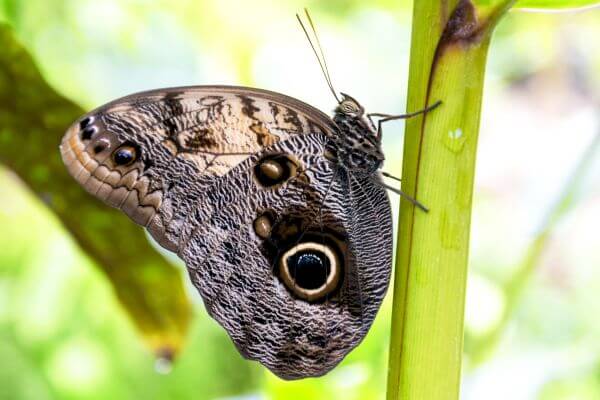Nature is an inexhaustible source of beauty and inspiration, and moths are a fascinating example of this splendor. These winged insects, often overlooked in favor of their cousins the butterflies, have a unique beauty and an intriguing history. In this article, we will explore the transformation of moths from common insects to flying works of art, highlighting their importance and fascination in the natural world and human culture.

The Fascinating Biology of Moths
Moths belong to the order Lepidoptera, which also includes butterflies. However, while butterflies are often associated with daylight, moths are known for their nocturnal activities. These insects come in a wide variety of shapes, sizes, and colors, but they all share a remarkable life cycle.
Moths go through a complete metamorphosis, starting out as eggs, then turning into larvae known as caterpillars. During the caterpillar stage, they go through several stages of development, changing their appearance and growing until they reach the pupal stage. Inside the pupa, the final transformation takes place, and a magnificent moth emerges, ready to take flight.
The Ecological Importance of Moths
In addition to their aesthetic beauty, moths play a vital role in ecosystems. As pollinators, they help many plants reproduce, promoting habitat diversity and sustainability. Moths also serve as a food source for several species, including birds and bats. Their presence or absence can significantly affect food chains and ecological balance.
However, moths face increasing threats due to habitat destruction, pollution and climate change. Understanding and protecting these delicate insects is critical to ensuring the preservation of biodiversity and the health of ecosystems.
The Human Fascination with Moths
Throughout history, moths have fascinated and inspired mankind. Its beauty and mystery have captivated artists, poets and scientists. Cultures around the world have attributed symbolic meanings to moths, associating them with renewal, transformation and spirituality.
Furthermore, these insects have aroused the curiosity of entomologists and scientists who are dedicated to studying their incredible diversity and adaptation to different landscapes and climates. With thousands of known species around the world, each with its own shape, pattern and color, moths are nature’s true works of art. Their graceful flight and camouflage abilities are a source of constant fascination, and the quest for new discoveries and understanding of these magnificent insects continues to drive scientific research.
The Art of Moths
The beauty of moths has been portrayed in countless forms of art, from paintings to sculptures and jewelry. Artists such as Odilon Redon and Salvador Dalí used the image of the moth as a symbol of metamorphosis and transformation in their works. The delicacy of moths’ colorful wings inspired fashion designers to create dazzling prints and fabrics.
Furthermore, the collage technique, popularized by artists such as Max Ernst, was influenced by the intricate structure of moth wings. The overlapping of different patterns and textures in collages reflects the complexity and diversity found in the wings of these beautiful insects. The subtlety of tones and elegance of moth designs have also found their way into the art of botanical printmaking and illustration, where they are depicted with scientific precision and a unique artistic appreciation.
Exploring the Collage
The collage technique, which consists of creating compositions by overlapping different elements, found a recurring theme in the moth. Using moth wings in collages adds a three-dimensional element and unique texture to artwork. Artists such as Vladimir Kush and Damien Hirst are known for their creations that incorporate moth wings, taking them to a new artistic level.
The combination of the delicacy of moth wings with the collage technique results in fascinating and captivating works of art. The variety of colors, patterns and sizes of moth wings offer a wide range of possibilities for artists to explore and create visually striking compositions. The careful overlapping of the wings creates a sense of movement and depth, while the wings’ transparency allows light to shine through them, giving the collages a luminous, ethereal effect. This union between the art of collage and the beauty of moths awakens the interest and admiration of spectators around the world, becoming a unique and unforgettable form of artistic expression.
The Moth in Popular Culture
In addition to the world of art, moths also have a strong presence in popular culture. They appear in movies, music, literature and even tattoos. His image is often associated with delicacy, transformation and freedom. The monarch moth, for example, is widely known for its annual migration of thousands of kilometers, a phenomenon that fascinates and inspires the human imagination.
Conservation
With the growing awareness of the importance of moths and the threat they face, conservation efforts are being undertaken around the world. These efforts include protecting natural habitats, creating specific breeding and feeding areas for the moths, and educating the public about their ecological importance. In addition, creating gardens and spaces with plants that attract moths has become a popular practice among nature enthusiasts. These gardens provide sources of food and shelter for moths, contributing to their survival and promoting local biodiversity.
Moths, often thought of as just common nocturnal insects, have the power to transform themselves into true flying works of art. Its beauty and ecological importance have aroused the interest and fascination of artists, poets and scientists throughout history. The presence of moths in art and popular culture is a testament to their ability to captivate and inspire the human imagination. However, it is essential to remember that moths also face significant threats due to habitat loss and environmental degradation. Protecting and conserving these delicate insects is critical to ensuring the health of ecosystems and the survival of moths as flying works of art.
Therefore, we must value and preserve the beauty of moths, recognizing their ecological importance and appreciating them as symbols of transformation and renewal. Only then can we guarantee that these nocturnal creatures continue to delight and inspire future generations, perpetuating their metamorphosis from common insects to flying works of art.
With these efforts, moths can continue to soar through the skies like true works of art, reminding us of the beauty and fragility of nature, and inspiring us to protect and preserve its existence. By valuing and appreciating moths as flying works of art, we can promote awareness of the importance of conserving biodiversity and ecosystems.
It is critical that each of us play an active role in the preservation of these magnificent creatures and their habitat. We can start by making conscious choices in our lifestyles, reducing the use of toxic chemicals in our gardens and supporting local conservation initiatives.
By appreciating the beauty of moths, we can find inspiration to create a more sustainable and balanced world where all forms of life can thrive. Each free-flying moth is a reminder that we are all part of an interconnected ecosystem and depend on each other to ensure a healthy and harmonious future for our planet.
So let us open our eyes and hearts to the beauty of moths and work together to protect them. May we recognize the intrinsic value of these insects and promote the conservation of their habitats, so that they continue to delight and inspire future generations, perpetuating their transformation from common insects to true works of flying art.
May the moths continue to remind us of the beauty that is all around us and the responsibility we have to protect it. May we fly along with them in search of a more harmonious world, where moths can continue to shine like true living works of art, enchanting us and inspiring us to value and preserve the beauty that nature generously offers us.

